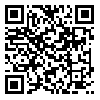Volume 15, Issue 4 (oct & Nov 2021)
payavard 2021, 15(4): 340-352 |
Back to browse issues page
Download citation:
BibTeX | RIS | EndNote | Medlars | ProCite | Reference Manager | RefWorks
Send citation to:



BibTeX | RIS | EndNote | Medlars | ProCite | Reference Manager | RefWorks
Send citation to:
Dolatkhahi K, Azar A, Karimi T, Hadizadeh M. Diagnosing Breast Cancer by Machine Learning. payavard 2021; 15 (4) :340-352
URL: http://payavard.tums.ac.ir/article-1-7139-en.html
URL: http://payavard.tums.ac.ir/article-1-7139-en.html
1- Ph.D. Candidate in Industrial Management Operations Research Orientation, Faculty of Management and Accounting, College of Farabi University of Tehran, Tehran, Iran
2- Professor, Department of Industrial Management, Faculty of Management and Economics, Tarbiat Modares University, Tehran, Iran
3- Assistant Professor, Department of Industrial and Technology Management, Faculty of Management and Accounting, College of Farabi University of Tehran, Iran ,tkarimi@ut.ac.ir
4- Assistant Professor, Cancer Research Center, Shahid Beheshti University of Medical Sciences, Tehran, Iran
2- Professor, Department of Industrial Management, Faculty of Management and Economics, Tarbiat Modares University, Tehran, Iran
3- Assistant Professor, Department of Industrial and Technology Management, Faculty of Management and Accounting, College of Farabi University of Tehran, Iran ,
4- Assistant Professor, Cancer Research Center, Shahid Beheshti University of Medical Sciences, Tehran, Iran
Abstract: (2053 Views)
Background and Aim: Cancer and in particular Breast cancer are among the diseases that have the highest mortality rate in Iran after heart disease. The accurate prognosis for Breast cancer is important, and the presence of various symptoms and features of this disease makes it difficult for doctors to diagnose. This study aimed to identify the factors affecting Breast cancer, modeling and ultimately diagnosing the risk of Breast cancer.
Materials and Methods: In the present study, first, by content analysis and library studies, the effective factors in Breast cancer were identified, then with the help of a team of experts consisting of physicians and subspecialists in Breast oncology and Breast surgery; With the help of the Delphi method, the factors were adjusted and 26 final factors that were numerically correct and string based on local and climatic conditions were approved. Then, according to the final factors and based on the medical records of 5208 patients in the Cancer Research Center of Shahid Beheshti University of medical sciences, to diagnose cancer, Decision Tree, Random Forest, and Support Vector Machine methods were used as machine learning methods.
Results: In the first step, by content analysis method, 29 effective factors in Breast cancer were identified. Then, taking into account the indigenous and climatic conditions and using the Delphi method and also using the opinions of 18 Experts during three years, 26 factors were finalized. In the final step, using the medical records of the patients and the results obtained from the three methods mentioned, random forest, had the highest accuracy of 94.75% and precision of 97.26% in diagnosing Breast cancer. It has been noted that, compared to other similar studies, indigenous databases have been exploited, the accuracy obtained has been very close to previous studies, and in many cases much better.
Conclusion: Using the random forest method and taking advantage of the factors affecting Breast cancer, the ability to diagnose cancer has been provided with greatest accuracy.
Materials and Methods: In the present study, first, by content analysis and library studies, the effective factors in Breast cancer were identified, then with the help of a team of experts consisting of physicians and subspecialists in Breast oncology and Breast surgery; With the help of the Delphi method, the factors were adjusted and 26 final factors that were numerically correct and string based on local and climatic conditions were approved. Then, according to the final factors and based on the medical records of 5208 patients in the Cancer Research Center of Shahid Beheshti University of medical sciences, to diagnose cancer, Decision Tree, Random Forest, and Support Vector Machine methods were used as machine learning methods.
Results: In the first step, by content analysis method, 29 effective factors in Breast cancer were identified. Then, taking into account the indigenous and climatic conditions and using the Delphi method and also using the opinions of 18 Experts during three years, 26 factors were finalized. In the final step, using the medical records of the patients and the results obtained from the three methods mentioned, random forest, had the highest accuracy of 94.75% and precision of 97.26% in diagnosing Breast cancer. It has been noted that, compared to other similar studies, indigenous databases have been exploited, the accuracy obtained has been very close to previous studies, and in many cases much better.
Conclusion: Using the random forest method and taking advantage of the factors affecting Breast cancer, the ability to diagnose cancer has been provided with greatest accuracy.
Keywords: Breast Cancer, Content Analysis, Delphi Method, Random Forest, Decision Tree, Support Vector Machine
Send email to the article author
| Rights and permissions | |
 |
This work is licensed under a Creative Commons Attribution-NonCommercial 4.0 International License. |





